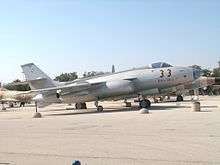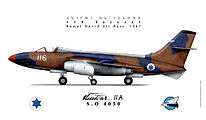Sud Aviation Vautour
| Vautour | |
|---|---|
| Role | Fighter-bomber |
| Manufacturer | Sud Aviation |
| First flight | 16 October 1952 |
| Introduction | 1958 |
| Retired | 1979 |
| Primary users | French Air Force Israeli Air Force |
| Produced | 149 |
|
| |
The Sud-Ouest Aviation (SNCASO) S.O. 4050 Vautour II was a French bomber, interceptor, and attack aircraft used by the Armée de l'Air (AdA). Later, 28 of these aircraft were used by the Israeli Air Force. Vautour is the French word for vulture.
Development
In June 1951 the French Armée de l'Air (AdA) issued a requirement for a jet aircraft capable of acting as a bomber, a low-level attack aircraft, or an all-weather interceptor. SNCASO adapted its existing S.O. 4000 for this purpose, the first prototype S.O. 4050 making its initial flight on 16 October 1952.[1]
Subsequently named Vautour II, the aircraft was built in three versions. It entered service with the AdA in 1958, with the last French aircraft leaving frontline service in 1979. A few soldiered on in various duties into the early 1980s. The Vautour saw no combat in French service, and for much of its AdA service life it was maligned as obsolete and underpowered. Although a moderately good aircraft when originally produced, it never received sufficiently powerful engines. As an interceptor it was outclassed by the Dassault Mirage III, and as a bomber or attack aircraft its lack of an advanced navigation/attack system was a crippling limitation.
The only export customer for the Vautour was Israel, which purchased 28 for the IDF/AF. The Israeli Vautours also entered service in 1958. They saw combat against Egypt beginning the following year and in a series of actions through the Six Day War and War of Attrition. The Israeli Vautours took part in bombing, strafing and air-to-air engagements. In the Six Day War, over three days Vautours fought repeated combats with Iraqi Air Force fighters while raiding H-3 airfield in Western Iraq. On June 6, 1967, Captain Ben-Zion Zohar scored the type's only aerial victory when he downed an Iraqi Hawker Hunter, although two Vautours fell to the guns of Iraqi Hunters on the following day.[2] In all 15 Vautours were lost. They were retired in 1971 in favor of the A-4 Skyhawk, and the last aircraft left service in March 1972, serving as decoys in the Sinai. The Israelis were pleased with the Vautour's range and versatility, and it was well regarded in Israeli service.
Design
The Vautour was a shoulder-wing monoplane with a 35° swept wing and a "flying" tail. Two SNECMA Atar 101 turbojet engines were carried in pods in the wings. It had bicycle-type landing gear, with the main units in the fore and aft fuselage and smaller stabilizing gear in the engine pods. The central fuselage carried a large 5.0 meter (16 ft 5 in) weapons bay and substantial internal fuel tankage.
The IIB bomber lacked radar and other modern navigation and attack systems, armaments were aimed by a bombardier housed in a glass nose section of the aircraft with the aid of a World War II-vintage Norden bombsight. Both the IIB and IIA were limited to clear-weather operations in daylight only. The IIN interceptor had some capacity for night and adverse weather though the use of its radar. In Israeli service, where the weather was generally favorable and daylight missions commonplace, the Vautour's lack of advanced targeting and navigation equipment was not a crippling limitation; however, in Europe it was considered a major disadvantage. As a result, the French AdA did not use the single-seat IIA in a frontline capacity, and most of its IIB bombers were quickly converted to IIBR standard to perform photo reconnaissance missions instead.[3]
In French service, the Vantour IIB could carry either a single AN-11 or AN-22 nuclear weapon in its internal weapons bay; although the primary carrier of those weapons would the Dassault Mirage IV, which would later replace the IIB. A fleet of 40 Vautour IIBs constituted the original air-based component of the French force de frappe, the Commandement des Forces Aériennes Stratégiques (CFAS) of the French Air Force, established in 1955.[3] Their performance were considered marginal for the strategic bomber role; thus, a requirement for a supersonic replacement aircraft was issued only a year later in 1956. The 1956 requirement would ultimately result in the selection and manufacturing of the Dassault Mirage IV bomber; Sud Aviation had also responded to the requirement with a proposal for a stretched Super Vautour. This unbuilt variant would have had a combat radius of 1,700 miles while travelling at a speed of Mach 0.9.[4]
Variants
- S.O. 4050-01 : Two-seat all-weather fighter prototype, powered by two 23.5-kN (5,291-lb) Atar 101B turbojet engines. First flew on 16 October 1952. One built.
- S.O. 4050-02 : Single-seat ground-attack prototype, powered by two 27.6-kN (6,217-lb) Atar 101D turbojet engines. First flew on 16 December 1953. One built.
- S.O. 4050-03 : Two-seat bomber prototype, powered by two Armstrong Siddeley Sapphire turbojet engines. First flew on 5 December 1954. One built.
The Vautour was produced in three principal variants, which had 90% commonality:
- IIA: Single-seat, long-range attack aircraft, armed with cannon and bombs (carried internally or on four underwing pylons)
- IIN: Two-seat, all-weather interceptor with DRAC-25AI or DRAC-32AI radar in nose, pilot and co-pilot in tandem seats, armed with cannon, air-to-air missiles, and (theoretically) unguided rockets. The designation was later changed to II-1N.
- IIB: Two-seat bomber with glazed nose position for bombardier/observer replacing cannon pack, carrying bombs internally and on underwing pylons.
Some IIB aircraft were converted to various specialized roles, principally reconnaissance (IIBR and IIBN), ECM, and eventually target tug (IIB-TT).
Production
Total production was 149 aircraft, divided as follows:
- Prototypes: 3
- Pre-production: 6
- IIA: 30 (13 for France, 17 for Israel)
- IIB: 40 (36 for France, 4 for Israel)
- IIN: 70 (63 for France, 7 for Israel)
Operators

- Armee de l'Air received 112 aircraft.
- 92me Escadre de Bombardement operated the Vautour IIB and between 1970 and 1978, some Vautour IINs.
- Escadron de Bombardement 1/92 "Bourgogne"
- Escadron de Bombardement 2/92 "Aquitaine"
- Bombing Training Center operated Vautour IIB variant.
- 30me Escadre de Chasse Tout Temps operated the Vautour IIN and used several Vautour IIAs for training purposes.
- 1/30 "Loire"
- 3/30 "Lorraine"
- 92me Escadre de Bombardement operated the Vautour IIB and between 1970 and 1978, some Vautour IINs.
- Israeli Air Force received 31 aircraft, operating the type between May 1958 and April 1972.
- 110 Squadron based at Ramat David operated 19 Vautour IIA and four Vautour IIB aircraft.
- 119 Squadron based at Tel-Nof operated eight Vautour IINs.
 Vautour A
Vautour A Vautour B
Vautour B Vautour N
Vautour N
Specifications (Vautour IIA)

Data from
General characteristics
- Crew: One
- Length: 15.57 m (51 ft 1 in)
- Wingspan: 15.10 m (49 ft 6.5 in)
- Height: 4.94 m (16 ft 2.5 in)
- Wing area: 45 m² (484 ft²)
- Empty weight: 10,000 kg (22,000 lb)
- Loaded weight: 17,500 kg (38,600 lb)
- Max. takeoff weight: 21,000 kg (46,300 lb)
- Powerplant: 2 × SNECMA Atar 101E-3 turbojets, 34.3 kN (7,710 lbf)) each
Performance
- Maximum speed: Mach 0.9, 1,106 km/h (687 mph) at sea level
- Range: 5,400 km (3,375 mi)
- Service ceiling: 15,200 m (50,000 ft)
- Rate of climb: 60 m/s (11,820 ft/min)
- Wing loading: 403 kg/m² (82.6 lb/ft²)
- Thrust/weight: 0.4
Armament
- 4x 30mm DEFA cannons with 100 rounds per gun
- Internal weapons bay for maximum of 2,725 kg (6,000 lb) of bombs (typically six 450 kg (1,000 lb) bombs), pack of 116x 68 mm (2.7 in) rockets, camera pack, or two 1,500 liter (400 U.S. gal) fuel tanks
- Four underwing pylons each rated at 1,500 kg (3,300 lb) (inboard) and 500 kg (1,100 lb) (outboard) for total external load of 4,000 kg (8,800 lb); maximum practical weapons load (internal and external) 4,400 kg (9,700 lb) of bombs, rockets, missiles, or napalm tanks
See also
- Aircraft of comparable role, configuration and era
- As Fighter-Bomber / Light Bomber:
- As All-Weather Interceptor:
References
Notes
- ↑ Gunston 1981, p. 215.
- ↑ Aloni, Shlomo. "In a class of its own. The story of the Sud Aviation Vautour in Israeli Service." Air Enthusiast, 72. November/December 1997. pp. 50-55.
- 1 2 Gunston 1973, p. 105.
- ↑ Gunston 1973, p. 104.
Bibliography
- Gunston, Bill. Bombers of the West. New York. Charles Scribner's and Sons, 1973. ISBN 0-68413-623-6.
- Gunston, Bill. Fighters of the Fifties. Cambridge, England. Patrick Stephens Limited, 1981. ISBN 0-85059-463-4.
External links
| Wikimedia Commons has media related to SO 4050 Vautour. |